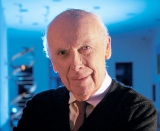Awards
- Honorary Degree - 1963
- D.S.
- Doctor of Science
- Commencement
- Bloomington, Indiana
- Presenter: Elvis Jacob Stahr, Jr.
- Nobel Prize - 1962
- Nobel Prize in Physiology or Medicine

James D. Watson was only 22 years old when he completed a Ph.D. at Indiana University in 1950. Just three years later he and fellow researcher Francis Crick would discover the structure of the DNA molecule, a twisted double helix that carries the genetic information for all know living organisms. Today the results of that discovery continue to dominate biological and medical sciences and other fields from diagnosing diseases to making pharmaceuticals to treat them, from cloning to developing disease-resistant farm animals and plants.
A native of Chicago, James earned his undergraduate degree in zoology at the University of Chicago. In 1947 he accepted a fellowship for graduate study in zoology at Indiana University, where he was deeply influenced by geneticist Hermann J. Muller and Tracy M. Sonneborn, and by microbiologist Salvador Luria. Under Luria's direction, Watson completed his Ph.D. thesis on the effect of hard rays on the multiplication of bacteriophages (viruses that infect bacteria). He received an IU honorary doctor of science degree in 1963.
Watson continued his study of bacteriophages in Copenhagen as a Merck Fellow of the National Research Council. At the conference in 1951 he met Maurice Wilkins and observed for the first the X-ray diffraction pattern of crystalline, which inspired him to change the direction of his research to the structural chemistry of nucleic acids and proteins. Luria then helped arrange with John Kendrew for Watson to pursue this line of inquiry at the Cavendish Laboratory at Cambridge University. There Watson met Francis Crick, and the two men began collaborating in their quest to solve the structure of DNA. By 1953, they had proposed the complementary double helix. Watson left to spend two years at the California Institute of Technology, before returning to the Cavendish Laboratory and his collaboration with Crick.
In 1956 Watson joined the faculty of the Department of Biology at Harvard University. In 1962, Watson, Crick, and Maurice Wilkins received the Nobel Prize in Physiology or Medicine for their discoveries concerning the molecular structure of nucleic acids and its significance for information transfer in living materials.
In 1968, Watson became director of the Cold Spring Harbor Laboratory on Long Island, New York, where he also served as president for 35 years and then as chancellor. For many years his research at Cold Spring Harbor has focused on cancer.
Under the auspices of the National Institutes of Health, Watson helped to initiate the Human Genome Project between 1988 and 1992.
Watson is the author of a number of textbooks and general audience books; the best known is The Double Helix: A Personal Account of the Discovery of the Structure of DNA.
Watson's legacy has been marred by racist and sexist comments and writings and he remains a polarizing figure despite his scientific achievements.